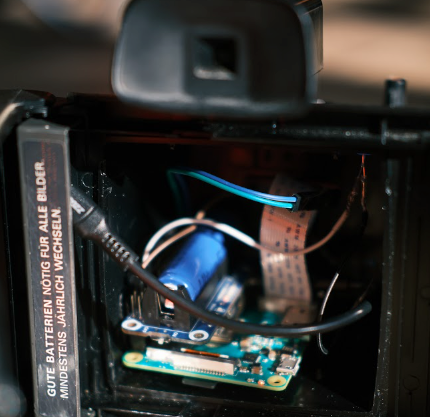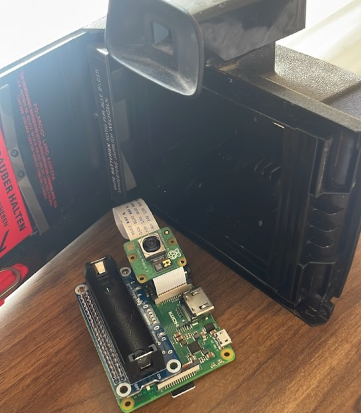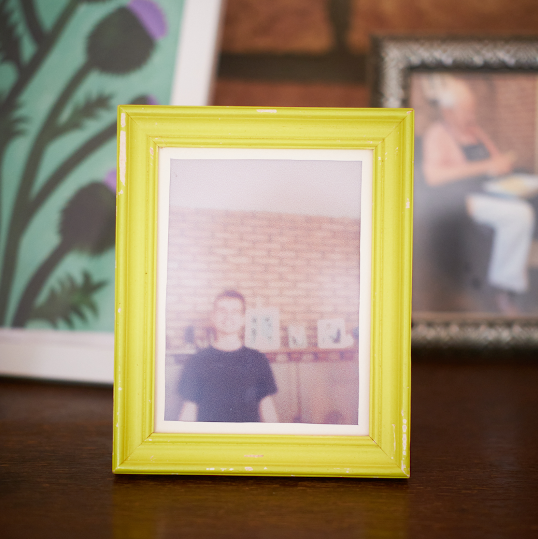A flash of inspiration
Using a Raspberry Pi Camera Module 3, a couple of Raspberry Pi 3 Model A+ boards, and some Python code, along with the other required bits of hardware, Max has essentially created a camera within a camera here, as a digital camera is hidden within the body of the original shell. “When the camera’s button is pressed, it makes a hidden digital camera take a picture,” he explains. “This picture is sent to a server, for the display frame to show.”
Interestingly, Max decided that he wanted the picture to then be deleted from the camera itself and, once the frame has downloaded this picture to display it, it is deleted from its storage as well. “I really like the idea of having only one copy of the picture baked into the e-ink display. It makes the picture feel important, and it fits with the essence of Polaroid photos,” declares Max. When a new picture is taken, the old one disappears from the frame.
The e-paper display module was a key inspiration to Max to make the photo frame: “I really like the look of a display that doesn’t emit any light, so it’s more like an e-book instead of a screen. It’s really fun to see the individual dots on it; it looks just like a real print.” When he found a type of e-paper that could do colours, there was no stopping him. “The slow drawing speed of the e-paper module (~1 minute) fits with the idea of mimicking developing film, which was a happy accident,” he enthuses.
Max was determined that the camera should send pictures to a server, instead of directly to the other device, so that it works “even if both devices are on opposite sides of the planet.” Deciding against using a SIM card in the camera and frame, he instead opted for Wi-Fi, and the camera simply connects to Wi-Fi networks by taking a picture of a QR code.
Shooting the snags
Max found that the physical build was the hardest element of the project, and many hours of work went into the venture. “At first, I only made little steps at a time for a couple hours a week but, once it started taking shape, I dedicated a few days to it to make some real progress,” he reveals. Most of his time went into the physical photo frame and the camera body. “Breaking the camera open on the inside without breaking it on the outside was a bit of a tedious task. And the photo frame needed a wooden shape on the back to fit the computer and wires, so that became a little arts‑and-crafts-session.”
Max’s father was on hand to help him with the woodwork for the frame, but “I was scared I’d break the camera when drilling a hole through the top for an LED light,” he shares. Also, making the real camera’s button trigger a signal necessitated some good old-fashioned trial and error. “I ended up using a metal spring with aluminium foil on it, and the ends touch when the button is pressed to make a closed circuit.”
Finally, deciding on power options for the camera demanded some further head-scratching – “I ended up using a battery HAT that works for about an hour on this setup and can be recharged with USB-C.” The end-product was well worth the labour and troubleshooting required en route, however. As long as there is Wi-Fi available, “the photos you take with the camera appear instantly on the display frame, no matter where in the world each of them is.”
No negatives here
Understandably, many people have enjoyed reading about Max’s camerawork.“There were a lot of positive reactions online! I really loved reading them. All the individual steps to making this project are nothing new, but bringing them together into this simple idea is what people seemed to appreciate the most.”
Significantly, he has had messages from a number of people who are keen to replicate his endeavours using similar vintage cameras. Describing this as “super-cool”, Max is very keen that people make their own variations and, indeed, improvements to the project. “One possible variation someone told me about was to make multiple photo frames and connect them to the same camera, so you can update a whole group at once! That could be fun.”





